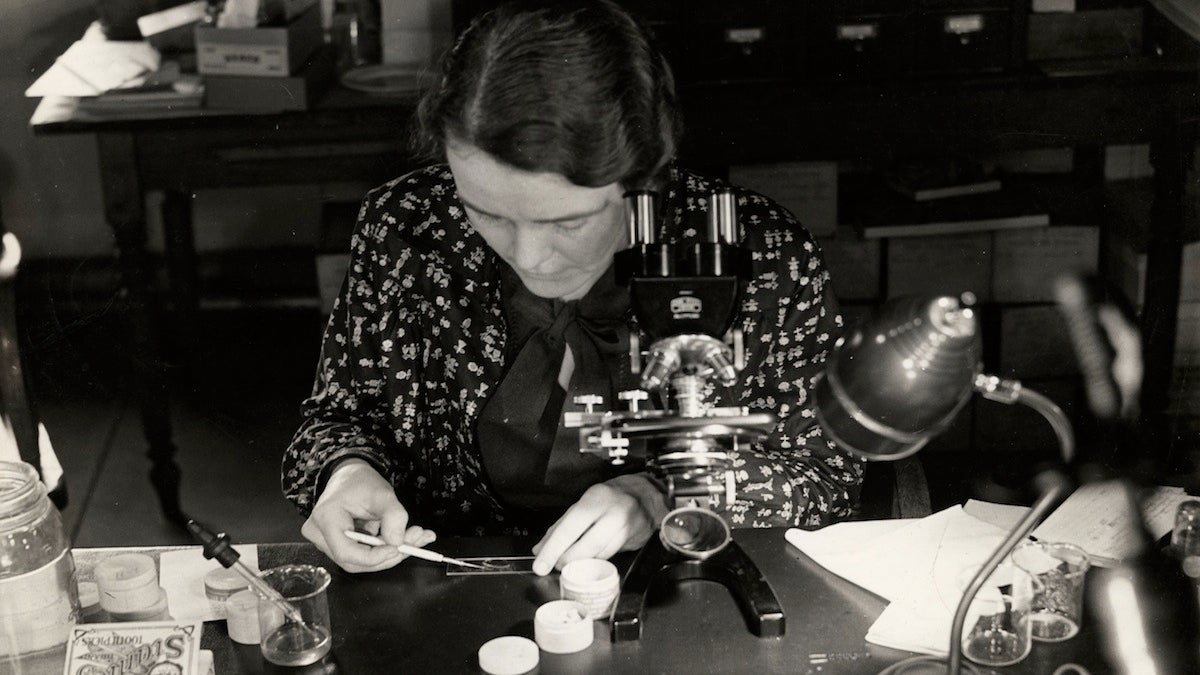Famed ecologist and longtime Chestnut Hill resident Ruth Patrick remembered by former apprentice

Dr. Ruth Patrick examines diatom slides at the Academy of Natural Sciences in the 1940s. (Courtesy of the Academy of Natural Sciences Archive)
Environmental scientist and longtime Chestnut Hill resident Dr. Ruth Patrick died at the age of 105 in Lafayette Hills, Pa. on Monday.
At a time when few women were active in her field, Patrick, who received the National Medal of Science in 1996, developed a method of evaluating freshwater ecosystems that is still the bedrock of ecological studies around the world today.
Thomas Dolan III was a newly-minted zoologist in 1948 when he first went to work for the world-famous ecologist on Pennsylvania’s Conestoga River. Dolan, a former director of the Wissahickon Valley Watershed Association and former Chestnut Hill resident, spoke with NewsWorks about his work with Patrick, who he said was an important mentor to him.
Morning in the swamps
Patrick had collected scientists from across the country to test her hypothesis that water quality and pollution are related to the diversity of the species that could be found in the waterway. The more species there are, from diatoms (a kind of algae) and microscopic protozoa to fish, the cleaner the waterway.
Dolan said it was a rowdy crew of men that descended on the river that summer, many of them veterans of the war. They slept in the dorms at Franklin & Marshall College and woke up to an irrepressible chemist calling, “Rise and shine, cowpoke. Daylight in the swamp!”
“We would get into the trucks with our boats and our nets and collecting gear,” he remembered, and fan throughout the tributaries of the river to collect their specimens, which they brought back to the school’s lab for identification, work that often went on until midnight.
Before they entered the lab, Patrick was always waiting for them. “We liked to drink and have a good time,” Dolan remembered. Patrick, then in her forties, “had never managed such a crew before.”
Schooling the boys
She was such a “delightful person,” he said, that she’d often join the men for games of tennis and roast beef suppers, “with all the appropriate libations to go before.” But Dolan also recalled that she wasn’t afraid to take her scientists firmly in hand when needed.
“We were a very rambunctious group, and I remember one time when we’d had a particularly fun evening,” he said, “we didn’t hit the laboratory quite as early as we might have. In fact, we probably didn’t get there at all.” But Patrick was waiting the next morning, and what she did next is one of Dolan’s favorite memories of her.
“You really got out of order last night, and for that, you are grounded. You’re not allowed out today,” she said, according to Dolan. “We might as well have been back in school.”
A few years later, Patrick, Dolan and the crew began to travel across the country, testing waterways for the DuPont Company, where Patrick eventually became the first woman and the first environmentalist to join the board of directors.
An unparalleled career
Patrick, a native of Topeka, Kansas, was born in 1907 and spent most of her childhood in Kansas City, Mo. Her devoted father took the then-unusual step of encouraging his young daughter’s interest in the natural sciences.
She received her undergraduate degree in biology in 1929, and went on to earn her master’s and Ph.D. in botany from the University of Virginia. She began her 80-year association with Philadelphia’s Academy of Natural Sciences when she arrived to study diatoms in 1933. According to an Academy release, she was named the assistant curator of microscopy there in 1937, but she wasn’t put on the payroll until 1945.
She went on to establish the Academy’s Department of Limnology, now called the Patrick Center for Environmental Research. She took a comprehensive view of the ways pollution impacts aquatic ecosystems when the science was in its infancy. She proved her hypothesis that biological diversity is an important harbinger of environmental health, and studied pollution in streams before Rachel Carson caught the public’s attention with Silent Spring.
A professor, author, researcher, leader, and recipient of many prestigious awards, she advised President Ronald Reagan on water pollution and acid rain and helped Congress to draft the Clean Water Act in the 1960s.
At age 100, she was still working in her office at the Academy of Natural Sciences and eating lunch in the cafeteria.
The scientist and the crab
Dolan acknowledged that Dr. Patrick had a lot to prove as a female scientist in the mid-20th century.He especially recalls one day down on the Guadalupe River in Texas, during a DuPont photo op. The team would collect the fish they studied in specialized nets, and in front of all the cameras, it was Patrick who reached her hand into the net.
“And what was in there: not the fish, but blue crabs,” Dolan said. “A very large one, male, got hold of her finger, and I could see the blood starting.” But Patrick gave no sign of the surprise: “I was right beside her…I could see the tears starting to come out of her eyes, but she never let anybody know it. That was so typical of her.”
Patrick revolutionized environmental science, but Dolan also remembers her as an unfailingly “gracious” person who never lost sight of life’s lighter side.
Over tea one day, she had a special request for her longtime colleague and friend. “One of these days I’m going to turn up my toes and there’s going to be a service,” she said. “I want you to get up and tell people about how much fun we had.”
A service is planned for Dr. Ruth Patrick at the Presbyterian Church of Chestnut Hill in spring 2014.
WHYY is your source for fact-based, in-depth journalism and information. As a nonprofit organization, we rely on financial support from readers like you. Please give today.




